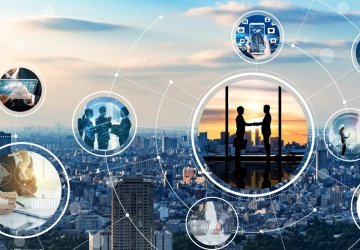
In the years to come, office buildings will transform faster and more dramatically than ever before to fulfill the changing needs of employees and visitors. In this blog series we examine three recent developments that are driving innovation in real estate and facilities management. While our previous blog focused on the impact of the COVID-19 pandemic, this one will explore the influence of Property Technology (PropTech). As more connected devices are used to generate data, how should we use that data to shape the office of the future?
IoT fueled by rise of PropTech
The development of Property Technology - or PropTech - represents a fundamental move toward the broad-scale digitization of buildings, with solutions provided by a variety of technology vendors for a multitude of purposes. As PropTech in general is quite extensive and covers a wide variety of use cases, it certainly supports the growth and possibilities of the Internet of Things (IoT).
Real-time office data
IoT sensors can provide data on a variety of actual office situations. For example, they can measure temperature and humidity, but also air quality in terms of CO2 levels and other components - a topic that has increased in significance due to COVID-19. In addition, cameras and motion sensors can provide insight into the number of people present in the office. You could even begin to chart movements through a building to better understand bottlenecks, as well as underutilized space.
McKinsey expects that organizations will spend six times more on IoT technology in 2023 than they did in 2014. According to various forecasts, more than 30 billion devices worldwide will be connected to the Internet via IoT technology in 2030.
An example: Soap dispensers with Wi-Fi
However, even those numbers around IoT may be conservative, because sensors are becoming more affordable and have a long lifespan. You can even buy soap dispensers or toilet roll holders with a sensor and an internet connection, which can alert the facilities department when refilling is required. Is such a small-scale application necessary? Maybe, maybe not. However, data is valuable when you use it in a way that has a positive impact on productivity or user experience.
In other words, it is not about having the data, but about what you (can) do with it. What insights can you get out of it? How can you turn information into knowledge and eventually deepen your understanding? This is where Artificial Intelligence (AI) starts to play an increasingly significant role.
AI could benefit businesses in terms of time, efficiency and money. For example, an air conditioning (HVAC) installation could use AI to predict when the filters in its equipment will need to be replaced. If the filters are not replaced in time, the machine will use more power. Such a warning is useful, but you can only align policy to that information if you know when a maintenance visit is planned and can directly interact with the planning system of the relevant service provider in charge of replacing filters in this building. Secondly, you may not need to send a service engineer to replace just one filter, but what if you need to replace a hundred? Value is created when you know exactly at what point you are operating most efficiently. AI supports you in making optimal use of your data and sending the right service engineer to the right building at the right time.
PropTech and the work environment
The data from different sensors and smart assets is not only useful for facilities management and maintenance. It can also be used to enhance the workplace experience.
A healthy, comfortable employee is normally a happier and more productive employee as well. And, if sensors can measure temperature, humidity, CO2 levels and much more, then we can use algorithms to use that data to adjust the heating, ventilation and air conditioning to meet employee needs and expectations. Gaining better control of these quality levels can also save energy by ensuring that heating and lighting are switched off when no one is in a room. In combination with an app, it is possible to get direct interaction between a user and a room, by automatically adjusting the climate, lighting, and desk height to predefined levels. The workplace adjusts itself to the user.
Predicting behavior and outcome
If all the relevant devices and components in an office building generate data about the elements that have an impact on the office, it is even possible to build a digital copy of the office and perform tests with it. This “digital twin” provides an exact copy of the office allowing you to simulate how adjusting one variable might affect the occupancy of a department or the energy and maintenance cost for example.
With the help of machine learning and AI, smart software can create a best practice for running the office. Based on relevant data, it will allow you to find the perfect balance between comfort and costs, between occupancy level and well-being.
Fully realizing the potential of data
Many workplace and facilities management specialists still lack a full understanding of how much value their organizational data holds and how to utilize it effectively for their digital strategies. Is your organization fully utilizing the data already available? You can hear more about this topic in a webinar from IWFM, 3edges, and Planon where together they discuss the usage of data in workplace and facilities management. Watch the webinar on-demand for practical guidance on using data in an increasingly digital world.




















